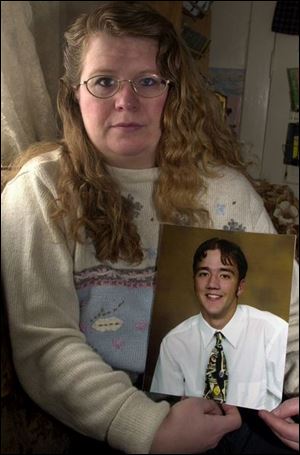
Light is shed on rail safety
11/3/2001
`Jeremiah would be here today if there had been reflectors on the railcars in front of him that night,' Laura Gomoll, with a photo of her stepson, wrote in a note to friends and relatives urging them to submit remarks to the Federal Railroad Administration. Jeremiah Gomoll died Dec. 22 when he drove his car into the side of a train.
A federal study has determined that placing reflector strips on the sides of railroad cars has become a cost-effective way to reduce crashes at highway crossings, a finding that could lead to regulations requiring reflector installation.
“Declines in the cost of reflective material, in combination with better performance and lower maintenance costs, have created a situation in which the benefits of reflectorization now appear to exceed its costs,” the Federal Railroad Administration said in an announcement published last week in the Federal Register.
The announcement was a pleasant surprise for Laura Gomoll of Lyons, whose stepson, Jeremiah Gomoll, died Dec. 22 when he drove his car into the side of a stopped train that blocked a rural grade crossing near Pettisville.
“Jeremiah would be here today if there had been reflectors on the railcars in front of him that night,” Mrs. Gomoll wrote yesterday in a note to friends and relatives urging them to submit remarks to the railroad administration as part of a public comment period that extends until Nov. 24.
Peggy Wilhide, a spokeswoman for the Association of American Railroads, said the trade organization would formulate a response and submit comments by the deadline.
“We need a chance to look at it,” she said.
After reviewing the comments, the railroad administration will decide whether to propose regulations requiring railcar reflectors, said Warren Flatau, an agency spokesman.
“At this point, no hearings are scheduled,” he said.
In 1994, Congress ordered the U.S. Department of Transportation to study railcar reflectors and establish visibility regulations if “enhanced railcar visibility would likely improve safety in a cost-effective manner.”
A 1980s-era railroad administration study found that though reflectors were effective, the materials available at the time were not durable enough for long-term use in the “harsh railroad environment.” But in the intervening years, more durable materials with better reflective qualities were developed.
Federal statistics show nighttime collisions in which vehicles struck the sides of trains behind the lead locomotive - the sort of collision reflective markings on freight cars might help prevent - accounted for 11,264, or about 6.4 percent, of 176,000 grade-crossing accidents reported between 1975 and 1996 in the United States.
Details from the railroad administration's cost-benefit analysis were not immediately available yesterday. Earlier research conducted by the Volpe National Transportation Systems Center estimated installation costs of $18.75 for new freight cars and $38.80 for older cars, which would need to be cleaned first, and calculated an overall cost of $219.25 per car for 10 years, including installation and maintenance.
About 1.7 million freight cars are in use in North America, including about 400,000 Canadian and Mexican cars that enter the U.S. rail network. Many newer cars have reflective markings, though not necessarily in the patterns that the Volpe center's research found to be most effective.